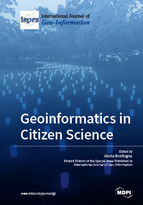Geoinformatics in Citizen Science
A special issue of ISPRS International Journal of Geo-Information (ISSN 2220-9964).
Deadline for manuscript submissions: closed (31 March 2018) | Viewed by 68746
Special Issue Editor
Interests: fuzzy logic and soft computing for the representation and management of imprecision and uncertainty of textual and geographic information; volunteered geographic information user-driven quality assessment in citizen science; crowdsourced information spatiotemporal analytics; information retrieval on the web; flexible query languages for information retrieval and geographic information systems; ill-defined environmental knowledge representation and management; multisource geographic information fusion and synthesis
Special Issues, Collections and Topics in MDPI journals
Special Issue Information
Dear Colleagues,
It is with great pleasure that I announce a call for papers for a Special Issue on "Geoinformatics in Citizen Science".
"Citizen Science" indicates an increasing collaborative practice to carry out scientific projects by the involvement of a large number of volunteer citizens who are called to perform some specific tasks. The diffusion of citizen science is testified by the growth of the European Citizen Science Association (ECSA) and the USA (Citizen Science Association), which enhances the participation by the general public in scientific processes, mainly by initiating and supporting citizen science projects.
This old practice, primarily born within the naturalistic field to enrich museum collections, with the advent of the Web and smart mobile devices connected to the Internet, has changed by sharply increasing both the quantity, the timeliness, and the worldwide provenance of volunteers, as well as the quantity, types and quality of their contributions.
These large changes make it possible to adopt this practice to a variety of new purposes, such as for monitoring processes varying in both space and time, thus constituting a new challenge for science, which calls for powerful means to process very large amounts of geoinformation.
In fact, geoinformation is a major dimension of the contributions provided by volunteers: Most citizen science projects in the naturalistic and environmental fields exploit Volunteer Geographic Information (VGI), that is, volunteers are asked to provide information of various types and nature, such as textual notes, pictures, measurements of properties relative to target objects or events, by associating a geographic reference with their observations which allow scientists studying the geographic distribution and changes of the habitats and environment. Other projects need to collect and analyze the geographic distributions of volunteers who declared diseases in order to study pandemics.
Thus, citizen science needs geoinformatics in order to easily collect information from the field, to filter such information with respect to its reliability and quality, and to cross-analyze it with respect to geoinformation from other sources (remote sensing, in situ sensors data, etc.) for the purpose of the projects.
On the other hand, geoinformatic research can fruitfully exploit citizen science projects to tackle novel issues, such as reliability assessment methods of volunteers, quality assessment of their contributions, spatial cross-analysis copying the uncertainty and imprecision of geoinformation, interoperable sharing of VGI, and to test newly defined methods with real data.
This Special Issue is dedicated to exploring current experiences and trends with regards to the conceptual, methodological, and technological approaches defined and used in citizen science projects for processing and analyzing geoinformation and of the social aspects related with their application. We call for original papers from researchers worldwide, both in geoinformatic communities and citizen science associations and projects.
Gloria Bordogna
Guest Editor
Manuscript Submission Information
Manuscripts should be submitted online at www.mdpi.com by registering and logging in to this website. Once you are registered, click here to go to the submission form. Manuscripts can be submitted until the deadline. All submissions that pass pre-check are peer-reviewed. Accepted papers will be published continuously in the journal (as soon as accepted) and will be listed together on the special issue website. Research articles, review articles as well as short communications are invited. For planned papers, a title and short abstract (about 100 words) can be sent to the Editorial Office for announcement on this website.
Submitted manuscripts should not have been published previously, nor be under consideration for publication elsewhere (except conference proceedings papers). All manuscripts are thoroughly refereed through a single-blind peer-review process. A guide for authors and other relevant information for submission of manuscripts is available on the Instructions for Authors page. ISPRS International Journal of Geo-Information is an international peer-reviewed open access monthly journal published by MDPI.
Please visit the Instructions for Authors page before submitting a manuscript. The Article Processing Charge (APC) for publication in this open access journal is 1700 CHF (Swiss Francs). Submitted papers should be well formatted and use good English. Authors may use MDPI's English editing service prior to publication or during author revisions.
Keywords
- Geoinformation in Citizen Science
- VGI in Citizen Science
- Crowdsourced Geoinformation Collection and Analysis






